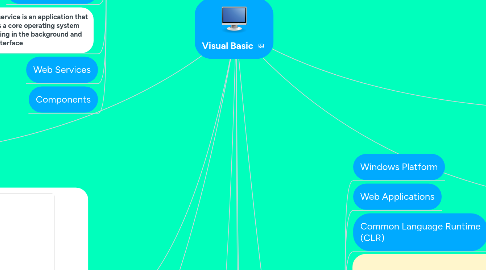
1. -Visual Basic is a user-friendly programming language designed for beginners -It enables anyone to develop GUI window applications easily. -VB.NET is a fully object-oriented programming language implemented in the .NET Framework.
2. https://www.vbtutor.net/images/vbproject.jpg
3. -In object-oriented programming and distributed object technology, a component is a reusable program building block that can be combined with other components in the same or other computers in a distributed network to form an application.
4. 1.Overview
5. Visual Basic application types
5.1. -Web services describes a standardized way of integrating Web-based applications -using the XML, SOAP, WSDL and UDDIopen standards over an Internet protocol backbone.
5.2. Windows
5.2.1. -A program that is written to run under the Microsoft Windows operating system, also called a "Windows app." - All 32-bit Windows applications run in the 32-bit and 64-bit versions of Windows. -Any 64-bit applications require 64-bit Windows, which is the standard on most modern desktop and laptop PCs.
5.3. Web
5.3.1. -It is a type of application that runs on a browser using a Web server configured with Microsoft Internet Information Services (IIS).
5.4. Console
5.4.1. -A console application is a computer program designed to be used via a text-only computer interface, such as a text terminal, the command line interface of some operating systems (Unix, DOS, etc.)
5.5. Windows Services
5.6. -A Windows service is an application that usually serves a core operating system function running in the background and has no user interface
5.7. Web Services
5.8. Components
6. -A program that is written to run under the Microsoft Windows operating system called a "Windows app." -All 32-bit Windows applications run in the 32-bit and 64-bit versions of Windows. -Any 64-bit applications (there are few by comparison) require 64-bit Windows, which is the standard on most modern desktop and laptop PCs.
7. -It is a type of application that runs on a browser using a Web server configured with Microsoft Internet Information Services (IIS). -In .NET, all web applications are built around The Official Microsoft ASP.NET Site, which is a part of .NET platform.
8. Visual Basic 1.0 was introduced in 1991. The drag and drop design for creating the user interface is derived from a prototype form generator developed by Alan Cooper and his company called Tripod. Microsoft contracted with Cooper and his associates to develop Tripod into a programmable form system for Windows 3.0, under the code name Ruby (no relation to the later Ruby programming language). Tripod did not include a programming language at all. Microsoft decided to combine Ruby with the Basic language to create Visual Basic. The Ruby interface generator provided the "visual" part of Visual Basic, and this was combined with the "EB" Embedded BASIC engine designed for Microsoft's abandoned "Omega" database system. Ruby also provided the ability to load dynamic link libraries containing additional controls (then called "gizmos"), which later became the VBX interface.
9. History
10. .Net framework elements
10.1. Windows Platform
10.2. Web Applications
10.3. Common Language Runtime (CLR)
10.3.1. http://www.developerin.net/include/ArticleImages/MSILCode.jpg
10.4. -.Net Framework provides runtime environment called Common Language Runtime (CLR) -It provides an environment to run all the .Net Programs. -Programmatically, when our program needs memory, CLR allocates the memory for scope and de-allocates the memory if the scope is completed.
10.5. .NET Framework Class Library
10.5.1. -This is also called as Base Class Library and it is common for all types of applications -The way you access the Library Classes and Methods in VB.NET will be the same in C#, and it is common for all other languages in .NET.
10.5.2. The following are different types of applications that can make use of .net class library. 1. Windows Application. 2. Console Application 3. Web Application. 4. XML Web Services. 5. Windows Services.
